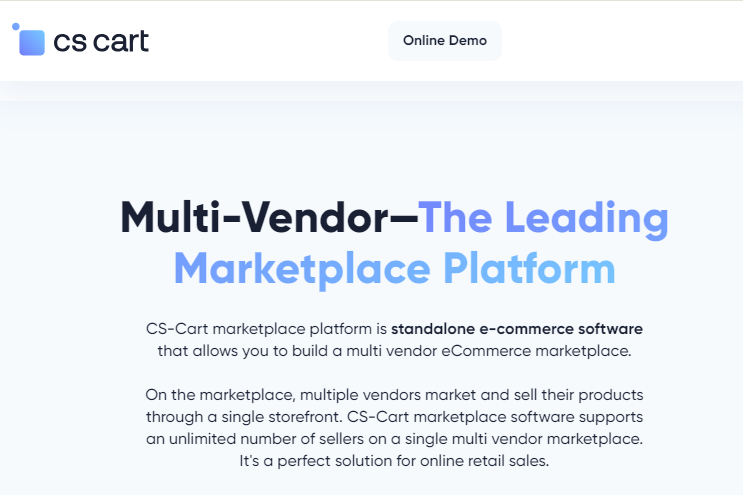Are you thinking about creating your own eCommerce marketplace?
-No problem, I got you covered!
In this article, I’m going to talk about the Best eCommerce Marketplace builders to help you create your own multi-vendor marketplace and skyrocket your eCommerce business.
First of all, let’s cover some basics concepts…
What is eCommerce?
As its own name may already indicate, eCommerce or electronic commerce is a modality of selling and buying products or services using the Internet as the main channel.
This type of commerce has quickly become very popular since the internet spread all around the world, and people started to feel more attracted to buying things online.
Having an eCommerce business has multiple advantages compared with the traditional commerce modality:
- Your business can be available for the customers 24/7 during the whole 365 days of the year.
- You have no geographical barriers to find new customers.
- More chances of being competitive compared with traditional commerce modality.
- You have the ability to segment your customers since everything is managed online.
- It makes it easier for you to communicate with your customers.
What is an eCommerce Marketplace?
When you hear the term eCommerce Marketplace you might immediately associate this term with big brands like Amazon, eBay, and Aliexpress.
These brand were the very first few people to really take full advantage of the eCommerce Marketplace business model, but as they did it, it means that there’s also plenty of opportunities for many other people to do the same.
Starting an eCommerce Marketplace consists of basically creating a market where you help both buyers and sellers, and as a return of that, you get a “small” commission of every sale made.
If we look at Amazon, for instance, their commissions will vary depending on the type of product with a maximum commission of 15% of the sale price, which is added to the shipping cost.
Some vendors are now competing with Amazon’s offer, or that’s what we might think. If you read the book “The Everything Store” that talks about Jeff Bezos, the founder of Amazon, you will understand in detail the strategy behind giving access to third parties.
Single-vendor Vs Multi-vendor eCommerce. What is the Difference?
Single-vendor Marketplace, also known as Stand Alone Website is an eCommerce website where you have a single vendor/seller/owner selling his products to multiple clients or buyers.
There are only two parties involved in this simple buying-selling process. One is the client or buyer and the other one as you can already figure out, is the vendor/seller.
The inventory or product listing is fully managed by the seller. Depending on the platform on which the site is built the vendor/seller will be able to list the product through the backend.
Multi-vendor Marketplace is a different model in which there are multiple sellers/vendors who sell their products through the platform/marketplace owned by an independent administrator.
In this case, the buyers or clients will come to the marketplace and get the opportunity to purchase the products from various sellers/brands.
In a multi-vendor marketplace, the products are listed by the vendors/sellers and are only visible/sold when the marketplace administrator approves them.
Let me give you a brief example: If a company like Apple, Samsung, or let’s even say Nike is selling their products on a site like Amazon or eBay then we’re looking at a Multi-Vendor Scenario where these brands are selling their products.
But if go to Apple’s own site or Samsung’s own site where they only sell their own products, then we’re looking at a Single-vendor eCommerce model.
-Not very complicated, right? Now, let’s get to the point…
What are The Best eCommerce Marketplace Builders?
CS-Cart Multi-Vendor
Pricing: $1450 (lifetime)
CS-Cart Multi-Vendor is a very powerful eCommerce software that allows you to easily create an online marketplace. With this software, you can actually have a Multi-Vendor eCommerce site where independent vendors can sell their products through a single storefront.
Advantages:
What I really like about this eCommerce software, is that it comes with all packaged into one single platform, which means that you won’t need to integrate any other plugin or service to your eCommerce Marketplace.
I also like the fact that although it’s cost is higher to some other eCommerce software, you can actually rest assured that you won’t have to pay anything next month, or even next year, since you get a lifetime access to the software and will also get the support from their team of experts.
Here are some of the key Admin features included:
- Advanced vendor payout system
- Flexible product approval system
- Detailed statistics and reports
- Configurable vendor plans
- Multiple levels of administrative access
- Advanced order management system
Here some key features included for vendors:
- Separate vendor panel
- Separate mini store for every vendor
- Real-time and manual shipping calculations
- Integration for Comments and reviews
- Vendor account balance, sales reports & statistics
- 26 built-in translations
Disadvantages:
The main disadvantage of CS-Cart Multi-Vendor when compared to other eCommerce Marketplace builders, is that is actually more costly, but it really depends on how we look at it.
The truth is that not everyone will be willing to pay $1450 to get a business started unless they’re really serious about it, but anyone who is really serious about starting a business won’t be really afraid of prices like this for a product that’s worth its value.
Magento Marketplace
Pricing: $349, apart from your Magento license fee.
Magento is an open source platform, something very similar to WordPress, but the difference is that it focuses primarily on eCommerce.
Magento Marketplace certainly offers one of the best ways to build an eCommerce business or online store, especially if you’re trying to build a multi-vendor eCommerce site.
Advantages:
Magento gives you the ability to add different extensions that can add more functionality to your already existent eCommerce business.
You get access to offer separate seller profiles for the sellers/vendors to log in and manage their own products. The vendors are able to modify various items in their profiles such as logos, media, product collections, and feedback.
I particularly like the fact that they have an extension that allows you to assign different commissions to every vendor.
Disadvantages:
Although you can establish your own eCommerce business with this tool, you can’t simply allow multiple vendors to operate on your site without the help of an extension.
The fact that you need to add extensions and also pay the Magento license fee can really make the overall cost much higher than other alternatives that at first might even look more expensive.
IXXO Cart Multi-vendor
Pricing: From $295 to $1495
IXXO Cart Multi_vendor is an eCommerce Marketplace builder that works very well on open source platforms such as WordPress or Joomla. Their system seems very powerful, but I wouldn’t really say that it’s a definitive solution.
Your eCommerce business will be hosted on your own servers, which gives you a higher level of control, ownership, and security, but it really requires some more technical knowledge.
Advantages:
What I personally like about this system is that you can run the system as a standalone store, but you also have the option to integrate it with a platform like WordPress.
Buyers can select products from multiple vendors in one single order, and also the vendors have many useful features such as choosing shipping methods, selecting different product templates and creating independent tax rules based on the type of product and location.
Disadvantages:
The actual cost of IXXO Multi-Vendor can really range drastically depending on what features you need, so it’s really not an all-in-one-packet solution.
Also, since you need to host the multi-vendor site on your own servers, it actually requires you to have a more technical knowledge and also make another investment on that.
Sharetribe
Pricing: $39 per month to $239 per month
Sharetribe is an eCommerce Marketplace builder that’s specifically dedicated to Multi-vendor eCommerce sites, so they don’t work with single-vendor eCommerce sites, at all.
They offer different pages that you can choose from depending on what you need, mostly based on how many vendors you’ll have in your eCommerce site.
Advantages:
What I like about Sharetribe is that they allow you to implement other types of eCommerce models besides sales, those include rentals, services and more.
Their software is not hard setup and it only takes a few minutes. They also offer a global payments system that’s good for accepting payments with almost any credit card or other online payment methods such as PayPal.
Disadvantages:
One notable disadvantage with Saretribe is that it provides limited customization features to the admins and vendors.
The listings need to be created manually, this is actually an issue if you need to create hundreds of listings, just to put an example.
Marketify
Pricing: $69 + $21 for one year of support
Marketify is actually a WordPress Theme that integrates a multi-vendor system, this is more intended for beginners who simply need to set up a WordPress site, implement the theme and start building the site from there.
Overall, this multi-vendor option works well for any type of eCommerce business, although it will, obviously, require a higher level of technical knowledge.
Advantages:
The Marketify theme integrates well with Easy Digital Downloads in order to enable you to sell downloadable products, and your users can log in with their social accounts to expedite the entire process.
The software integrates functionality customers to leave ratings and reviews, it also integrates beautiful video and audio previews in order to help customers make their decisions.
Disadvantages:
Since this is just a WordPress Theme, it requires the users to have technical knowledge on how to build the eCommerce site and also invest in a reliable hosting company.
The theme itself has a homepage that’s built using widgets rather than dedicated page builder UI. In order to turn your site into a fully-fledged eCommerce marketplace, you need to purchase premium EDD extensions.
Conclusion:
So here I’ve just mentioned what I consider the 5 Best eCommerce Marketplace Builders, based on my experience and also general reviews on the internet.
Now we must come to the conclusion as to which one would the be the best eCommerce Marketplace builder option after all.
When I think about the alternatives for building an eCommerce Marketplace and the fact that most of the options also include license fees, or will even require you to obtain other premium extensions to add more functionality.
This makes me want an option that comes with everything you need in order to start you eCommerce Marketplace business and continue to grow your business while you provide your vendors and customers (buyers) with all the tools they need and the best possible experience.
For that reason, I’ll choose the CS-Cart Multi-Vendor platform.
This platform provides a sleek, single storefront solution for vendors to make profiles and sell products. It comes with everything you need in order to build a successful eCommerce Marketplace, and you’ll only have to to pay once in order to get access for a lifetime.
That’s it for now… I hope this information is useful to you if you’re thinking about starting an eCommerce Marketplace. Leave your comments and questions below if you have any.



